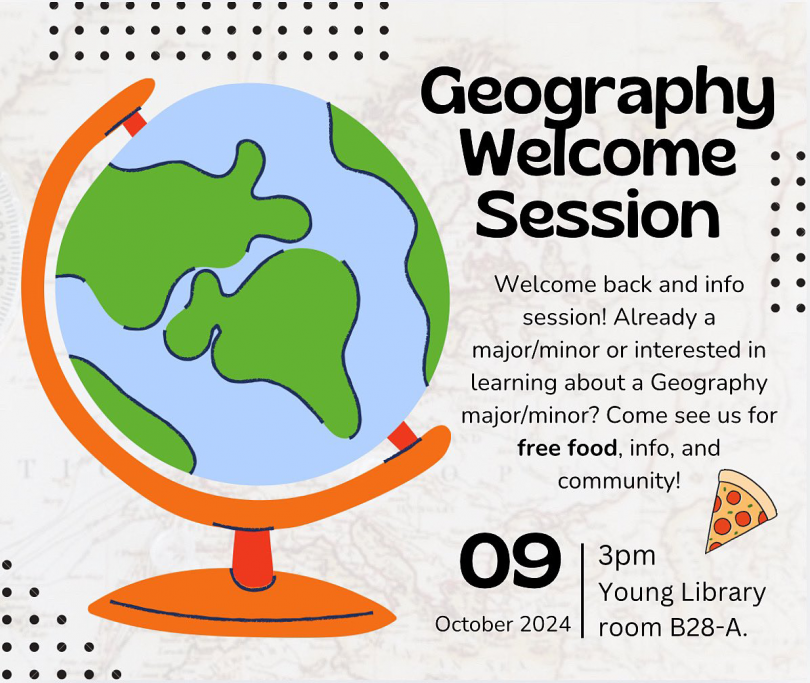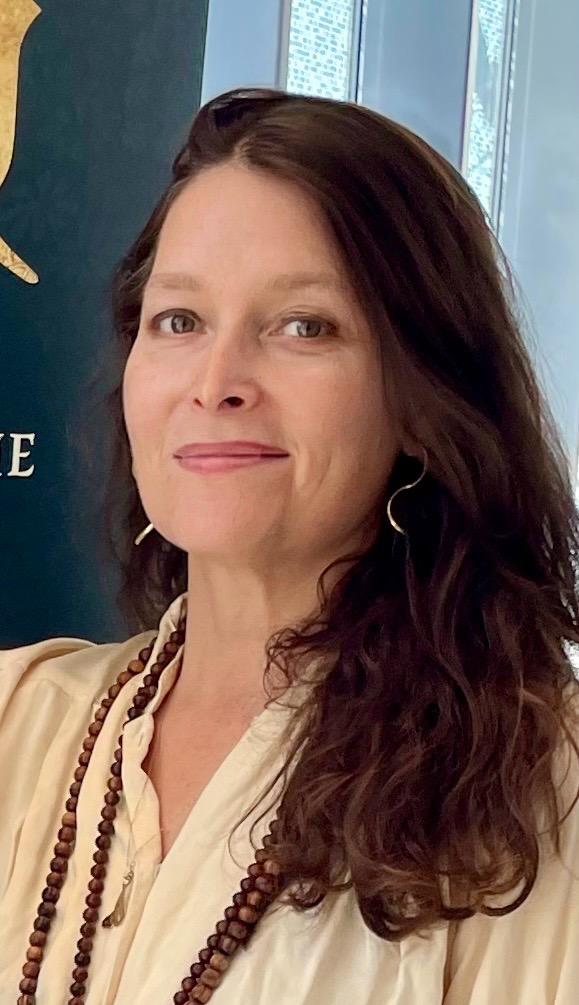2025 Annual Meeting of SEDAAG

Mark your calendars!
Lexington has been selected for the Annual Meeting of the Southeastern Division of the American Association of Geographers (SEDAAG), Nov 22-24, 2025. Book your hotel room here.

Lexington has been selected for the Annual Meeting of the Southeastern Division of the American Association of Geographers (SEDAAG), Nov 22-24, 2025. Book your hotel room here.
The Department of Geography would like to invite their Undergraduate Majors and Minors to a 'Welcome Back' event (with pizza!) to celebrate the new Academic Year. The event will be held in the WTY Library basement in room B-28A on Wednesday October 9th from 3:00-5:00. Hope to see you there!

 From simple tables to complex database searches, humans have created countless technologies for finding just the right data at just the right time. One such technology is the slide chart: a handheld device for on-the-fly calculations and information lookup. Slide charts typically consist of layered pieces of printed cardstock, plastic, or metal, which you can slide or turn to line up the pieces and reveal your desired information. The metal foot measurers at shoe stores are slide charts, as are slide rules and analog flight computers. While the term may be unfamiliar, the objects themselves are surprisingly ubiquitous, finding their way even today into homes, cockpits, classrooms, and healthcare facilities. Slide charts complicate the narrative of print culture smoothly giving way to digital culture, and this presentation uses slide charts as cyphers for examining what information people value and how we’ve chosen to organize, access, and use it over time.
From simple tables to complex database searches, humans have created countless technologies for finding just the right data at just the right time. One such technology is the slide chart: a handheld device for on-the-fly calculations and information lookup. Slide charts typically consist of layered pieces of printed cardstock, plastic, or metal, which you can slide or turn to line up the pieces and reveal your desired information. The metal foot measurers at shoe stores are slide charts, as are slide rules and analog flight computers. While the term may be unfamiliar, the objects themselves are surprisingly ubiquitous, finding their way even today into homes, cockpits, classrooms, and healthcare facilities. Slide charts complicate the narrative of print culture smoothly giving way to digital culture, and this presentation uses slide charts as cyphers for examining what information people value and how we’ve chosen to organize, access, and use it over time.
Lauren E. Cagle is an Associate Professor of Writing, Rhetoric, and Digital Studies and Director of Environmental and Sustainability Studies at the University of Kentucky, where she is also Affiliate Faculty in Appalachian Studies. Cagle is also the co-founder and Director of the Kentucky Climate Consortium (KYCC), a multi-institutional network of climate teachers and researchers in Kentucky higher education. Her teaching includes courses on scientific, environmental, and technical communication, and her research focuses on overlaps among digital rhetorics, research ethics, and scientific, environmental, and technical communication, frequently in collaboration with local and regional environmental and technical practitioners such as the Kentucky Division for Air Quality, the Kentucky Geological Survey, the UK Recycling Program, and The Arboretum, State Botanical Garden of Kentucky. She is currently writing a book on slide charts for the Parlor Press X-Series.

 In this talk, Dr. Anastasia Todd will discuss her newly published book Cripping Girlhood (Michigan, 2024). Cripping Girlhood offers a new theorization of disabled girls and girlhoods, tracing how and why the disabled girl frequently emerges in 21st century U.S. media culture. Through an analysis of media, from TikTok videos to GoFundMe campaigns, the book reveals how the exceptional figure of the disabled girl most often appears in media culture as a resource to work through post-Americans with Disabilities Act (ADA) anxieties about the family, healthcare, labor, citizenship, and the precarity of the bodymind. Going beyond a critique of the exceptional disabled girl, the book also examines disabled girls’ self-representational practices and cultural productions, showcasing the political and cultural labor disabled girls perform, from cultivating disability intimacies and community on YouTube, to affirming the value of care labor and interspecies interdependence on TikTok. Ultimately, Cripping Girlhood uncovers how disabled girls “crip” girlhood, or upend normative understandings of disability and girlhood, and in the process, circulate their own capacious re-envisioning of what it means to be a disabled girl.
In this talk, Dr. Anastasia Todd will discuss her newly published book Cripping Girlhood (Michigan, 2024). Cripping Girlhood offers a new theorization of disabled girls and girlhoods, tracing how and why the disabled girl frequently emerges in 21st century U.S. media culture. Through an analysis of media, from TikTok videos to GoFundMe campaigns, the book reveals how the exceptional figure of the disabled girl most often appears in media culture as a resource to work through post-Americans with Disabilities Act (ADA) anxieties about the family, healthcare, labor, citizenship, and the precarity of the bodymind. Going beyond a critique of the exceptional disabled girl, the book also examines disabled girls’ self-representational practices and cultural productions, showcasing the political and cultural labor disabled girls perform, from cultivating disability intimacies and community on YouTube, to affirming the value of care labor and interspecies interdependence on TikTok. Ultimately, Cripping Girlhood uncovers how disabled girls “crip” girlhood, or upend normative understandings of disability and girlhood, and in the process, circulate their own capacious re-envisioning of what it means to be a disabled girl.
“Stories of Ancient Resilience in the Maya Lowlands: Ancient Maya Hydrologic Landscapes”
The symbolic and social life of water was just as important to the Maya as their intricate hydraulic engineering. LiDAR mapping and fieldwork verification including geochemistry and paleoecology have confirmed more ancient Maya wetland agricultural sites in the Maya Lowlands than previously known, signifying its importance to the ancient Maya, and shedding new light on the spatial scale of hydrologic engineering, agricultural productivity, sustainability, and agricultural inputs to the Early Anthropocene. The Ancient Maya constructed a variety of hydrologic structures to manage soil moisture and water, including reservoirs, dams, canals, and wells. We use LiDAR mapping and site verification through multi-proxy evidence including water chemistry and soil chemistry, ecofacts and artifacts, and carbon dating for wetland fields’ and other hydrologic features’ origins and use, focusing on Northwestern Belize. This work draws from our three-decade record of studying Neotropical humanized landscapes and wetland agroecosystems and more recent quantification from ground-verified LiDAR imagery, and then places ancient Maya wetland agriculture in Belize and the Maya lowlands in the context of growing research on the broader Americas, and global research on the impacts of early agriculture on climate and the onset of the Early Anthropocene.

Sheryl Luzzadder-Beach is Professor in the Department of Geography and the Environment at the University of Texas at Austin, where she holds the Raymond Dickson Centennial Professorship of Liberal Arts, and is co-Director of the Beach/Butzer Geoarchaeology Labs. She served as Department Chair from 2014-2018, as the first woman to ever lead the Department. Dr. Luzzadder-Beach is Associate Faculty of the Theresa Lozano Long Institute of Latin American Studies and was Fellow of the C.B. Smith Centennial Chair in U.S.-Mexico Relations from 2014-2019. Her research specializes in Hydrology and Geoarchaeology of the Maya World, Geomorphology, Water Chemistry, and Spatial Statistics. She is a Fellow and Past President of the American Association of Geographers, and a Fellow of the American Association for the Advancement of Science. She received her M.A. and Ph.D. in Geography from the University of Minnesota, Minneapolis, and her B.A. in Geography from California State University at Chico.
 Prof. Henry Yeung's new book is entitled Theory and Explanation in Geography. In this colloquium, Dr. Yeung will present an overview of his work and provide an opportunity to discuss it. Dr. Yeung works in the field of economic geography, focusing on global production networks, East Asian development, and the political economy of globalization. His research critically examines how economic activities are organized across borders, emphasizing the roles of firms, states, and institutions in shaping global economic systems. He has published extensively on topics related to transnational corporations, regional economies, and global trade. Dr. Yeung holds the title of Distinguished Professor in the Department of Geography of the National University of Singapore (NUS). In 2025, Dr. Yeung will become the Choh-Ming Li Professor of Geography and Resource Management at the The Chinese University of Hong Kong.
Prof. Henry Yeung's new book is entitled Theory and Explanation in Geography. In this colloquium, Dr. Yeung will present an overview of his work and provide an opportunity to discuss it. Dr. Yeung works in the field of economic geography, focusing on global production networks, East Asian development, and the political economy of globalization. His research critically examines how economic activities are organized across borders, emphasizing the roles of firms, states, and institutions in shaping global economic systems. He has published extensively on topics related to transnational corporations, regional economies, and global trade. Dr. Yeung holds the title of Distinguished Professor in the Department of Geography of the National University of Singapore (NUS). In 2025, Dr. Yeung will become the Choh-Ming Li Professor of Geography and Resource Management at the The Chinese University of Hong Kong.
Published by Wiley in its RGS-IBG Book Series in September 2023, Theory and Explanation in Geography is one of the few provocative monographs in recent decades that engages deeply with epistemological debates on theory and method in Geography. This in-person event with the author invites readers and interested participants to examine critically the book’s main tenets and prospects for reflexive theory development as the key to the future of the discipline. The session provides an opportunity for the author to respond to comments and for the audience to engage in further discussions. After a brief introduction of the book by the author, the interactive discussion can potentially address wide-ranging issues, such as epistemology, styles and practices of theorizing in different critical approaches and “isms”, relational thought, processual thinking, mid-range explanatory theories, causal mechanism-based approach to theory and explanation, situated knowledges, “theorizing back”, and so on. The discussion will be relevant for colleagues and students in social and cultural geography, feminist and postcolonial geographies, critical geopolitics, environmental studies, urban geography, economic geography, and other topical interests within the geographical discipline and beyond.
Investment platforms have proliferated, spreading narratives, expectations, and practices of financial freedom and security. Platforms that facilitate real estate investment by ordinary people are a key site where financial subjectivities and individual capital become algorithmically networked to wider capitalist dynamics, within and beyond housing markets. Yet little is known about the geographically dispersed, atomized users who seek to secure financial futures through platform real estate investment. We address this challenge with an innovative methodology to examine how platforms mediate financial subjectivities and real estate. Our approach combines computational and textual analysis with in-depth qualitative study of a large corpus of conversations from a Reddit community dedicated to Fundrise, a major US investment platform. We find retail investors navigate both platforms to co-create networked financial subjectivity. Weaving polarized feelings with financial knowledge, they define financial goals and collective values through dynamics of in- and out-grouping and attempt to make sense of and frame real estate as an asset class. Countering wealth-tech’s narrative of democratization, we argue ordinary investors are unevenly captive to platform logic, attempting to negotiate a space for financial agency in a context of automation, stratification of users, and shifting digital and financial architectures. Seeking financial freedom, users construct their sense of proper financial subjectivity, struggling with and constrained by the platform’s own terms.
Desiree Fields is Associate Professor of Geography at UC Berkeley. She is an economic geographer and critical urban scholar. Her research program addresses how Wall Street and Silicon Valley are jointly transforming property relations, urbanization, and economic subjectivity. She has published widely in leading human geography and urban studies journals, including Annals of the American Association of Geographers, Progress in Human Geography, Environment and Planning A, and Urban Studies. Dr. Fields was a fellow of the Swedish Collegium for Advanced Study in 2023-24. She is a trustee of the Urban Studies Foundation and an editor at Environment and Planning A and Housing, Theory, and Society.
An agrarian geography lens helps clarify the ecological, social, experiential, cosmological, and even political-economic dimensions of what is framed as geopolitical. Overturning the nation-state as dominant scale of reference as well as the neoliberal hierarchy of ‘global’ over ‘local,’ agrarian geography grounds analysis in place-based knowledge, land-based life, social reproductive realms, embedded economics, and sovereignty. As such, it opens space for engaged agricultural policy co-analysis. Drawing on my research since graduating UK Geography, this presentation surveys key examples of how agrarian geography comprises geopolitics—from the seedkeeping tensions that led to and now fr acture both the International Treaty on Plant Genetic Resources for Food & Agriculture and the World Trade Organization Agreement on Agriculture to the grassroots coalitions that drafted and achieved the UN Declarations on the Rights of Peasants & Others Working in Rural Areas. The US Farm Bill began from farm justice movement demands for agricultural parity, just as the Indian farmers uprisings to protect minimum support prices cracked India’s BJP hegemony. An agrarian geography lens elucidates the land-based resistance at the heart of Cold War geopolitics, as well as of course the Haitian, Mexican, and anticolonial revolutions. It unmasks the current genocidal war on Palestine for the land grab it is. The rise of authoritarian ethnonationalism requires critical agrarian geographic analysis. Across Turtle Island, to counter colonialist, white supremacist connotations of ‘agrarian,’ abolitionist orientation is needed—from bell hooks' work to tracing the Kentucky River's Afro-Caribbean legacies. Accordingly, abolitionist agrarian geographies help cultivate emancipatory inter-agricultural relations, diálogo de saberes, and thus agricultural policy co-analysis.
acture both the International Treaty on Plant Genetic Resources for Food & Agriculture and the World Trade Organization Agreement on Agriculture to the grassroots coalitions that drafted and achieved the UN Declarations on the Rights of Peasants & Others Working in Rural Areas. The US Farm Bill began from farm justice movement demands for agricultural parity, just as the Indian farmers uprisings to protect minimum support prices cracked India’s BJP hegemony. An agrarian geography lens elucidates the land-based resistance at the heart of Cold War geopolitics, as well as of course the Haitian, Mexican, and anticolonial revolutions. It unmasks the current genocidal war on Palestine for the land grab it is. The rise of authoritarian ethnonationalism requires critical agrarian geographic analysis. Across Turtle Island, to counter colonialist, white supremacist connotations of ‘agrarian,’ abolitionist orientation is needed—from bell hooks' work to tracing the Kentucky River's Afro-Caribbean legacies. Accordingly, abolitionist agrarian geographies help cultivate emancipatory inter-agricultural relations, diálogo de saberes, and thus agricultural policy co-analysis.
Born and raised in an agricultural community in Kentucky only beginning to reckon with its history of settler colonialism and slavery, Garrett Graddy-Lovelace now researches and teaches agricultural policy and agrarian geography as Provost Associate Professor of Environment, Development & Health Department at American University School of International Service (DC/Piscataway lands), where she co-founded the Ethnographies of Empire Research Cluster. Drawing on community-based scholarship, she also co-founded UK's Political Ecology Working Group, the Disparity to Parity project, the Agroecology Research-Action Collective, and the Pointing the Farm Bill toward Racial Justice initiative. She has a Masters of Theological Studies from Harvard Divinity School and is a proud 2011 alum of University of Kentucky’s Geography PhD Program.
Every year between 1998 to 2020 except one, Louisiana had the highest per capita rate of incarceration in the nation and thus the world. Prison Capital: Mass Incarceration and Struggles for Abolition Democracy in Louisiana (UNC Press) is the first book to track the multiscalar formation and contestation of the Louisiana carceral state. Through extensive research, Lydia Pelot-Hobbs illuminates how policy makers enlarged Louisiana’s carceral infrastructures with new prisons and jail expansions alongside the bulking up of police and prosecutorial power. Understanding Louisiana’s carceral crisis extends our understanding of the interplay between the crises of mass criminalization and racial capitalism while highlighting the conditions of possibility for dismantling carceral power in all its forms.
Lydia Pelot-Hobbs is an Assistant Professor of Geography and African American & Africana Studies at the University of Kentucky where she teaches and researches on the carceral state, racial capitalism, and grassroots social movements. She is the author of Prison Capital: Mass Incarceration and Struggles for Abolition Democracy in Louisiana (UNC Press) and co-editor of The Jail Is Everywhere: Organizing Against the New Geography of Mass Incarceration (Verso Books).